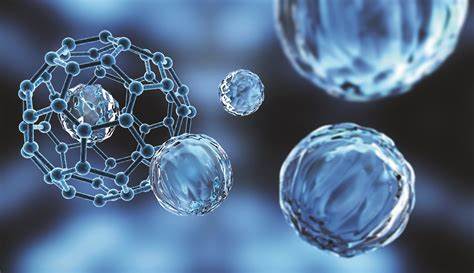Nanotechnology in Drug Delivery system
Uncategorized
Introduction:
Drug development and delivery encompass the process of discovering, developing, manufacturing, and administering therapeutic agents to treat or prevent diseases. It involves interdisciplinary collaboration among scientists, clinicians, regulatory agencies, pharmaceutical companies. Nanotechnology has revolutionized drug delivery by offering solutions to different challenges faced by traditional drug delivery systems. Nanotechnology is an emerging technology in the field of drug delivery using the nanoparticles 5 to 200 nanometers in size. In the techonology the drug can be protected against chemical and enzymatic degradation by entrapping and dissolving the drug into different types of biodegradable nanoparticles. The nanoparticles are made up of nanomaterials which may be composed of proteins, polymers, polysaccharides, etc. It is highly specific as well as target oriented. The nano particles have very low side effects, can protects the drug from degradation, and a smaller number of doses with less amount of active pharmaceutical ingredient is required. The ultimate goal of nano-drug delivery system is to develop clinically useful formulation with minimum dose and minimum side effects for treating diseases in patients. Here we have discussed about the different nanotechnology based materials used in the drug delivery like dendrimers, liposomes, micelles their properties and applications. Besides all aspects the toxicity of the nano particles is also of much health concern, which should be take care of while using them.
Drug development and delivery face several challenges and problems that hinder the development of safe and effective therapies. Some of the common issues include:
- Drug Discovery and Development Costs:The cost of bringing a new drug to market is exceedingly high, with estimates ranging from hundreds of millions to billions of dollars. This high cost is due to extensive research, preclinical testing, and clinical trials required to demonstrate safety and efficacy.
- Drug Development Timeline: The drug development process is lengthy and time-consuming, typically taking 10-15 years from initial discovery to market approval. Delays in regulatory approvals, clinical trial recruitment, and unexpected safety concerns can prolong the timeline further.
- High Failure Rates: The majority of drug candidates fail during preclinical and clinical development due to efficacy, safety, or regulatory issues. The high failure rate underscores the need for more predictive preclinical models, biomarkers, and innovative drug discovery approaches.
- Safety Concerns:Drug safety is a significant concern, with adverse drug reactions being a leading cause of morbidity and mortality worldwide. Improving safety assessments, understanding drug interactions, and identifying biomarkers for patient stratification are critical areas for improvement.
- Drug Resistance:Resistance to antibiotics, antiviral drugs, and cancer therapies poses a significant challenge in healthcare. Strategies to combat drug resistance include the development of novel therapeutics, combination therapies, and precision medicine approaches tailored to individual patients.
- Target Identification and Validation:Identifying and validating suitable drug targets is a complex and challenging process. Advances in genomics, proteomics, and bioinformatics have facilitated target discovery, but translating these discoveries into clinically viable therapies remains a bottleneck.
- Biological Barriers: Biological barriers, such as the blood-brain barrier, mucosal barriers, and tumor microenvironment, limit drug delivery to target tissues and cells. Overcoming these barriers requires innovative drug delivery systems, nanotechnology-based approaches, and targeted therapies.
- Regulatory Hurdles:Regulatory requirements for drug approval vary across regions and can be stringent, leading to delays in market access. Streamlining regulatory pathways, accelerating approval processes, and promoting collaboration between regulatory agencies and industry can expedite drug development.
- Access to Healthcare and Affordability:Ensuring equitable access to essential medicines and affordable healthcare remains a global challenge. High drug prices, particularly for specialty drugs and biologics, can limit patient access and strain healthcare systems.
- Emerging Technologies and Therapeutic Modalities: Advances in technologies such as gene editing, RNA-based therapeutics, cell therapy, and personalized medicine offer promising new avenues for drug development but also present unique challenges related to safety, efficacy, and scalability.
- Addressing these challenges requires a collaborative effort involving academia, industry, regulatory agencies, healthcare providers, and patients. Investment in research and innovation, adoption of new technologies, and implementation of regulatory reforms are essential for overcoming current obstacles and advancing drug development and delivery.
Benefits of using nanotechnology in drug delivery:
- Targeted Delivery:Nanoparticles can be engineered to target specific cells or tissues, reducing side effects and increasing drug efficacy. Functionalization of nanoparticles with ligands that recognize receptors on target cells enables precise delivery.
- Improved Solubility:Many drugs have poor solubility, limiting their effectiveness. Nanoparticles can encapsulate poorly soluble drugs, improving their solubility and bioavailability.
- Extended Release:Nanoparticles can be designed to release drugs slowly over time, providing sustained therapeutic effects and reducing the frequency of dosing.
- Protection of Drugs:Nanoparticles can protect drugs from degradation in the body, enhancing their stability and prolonging their circulation time.
- Passive Targeting:Nanoparticles can exploit the enhanced permeability and retention (EPR) effect, which causes them to accumulate preferentially in tumors due to leaky blood vessels and poor lymphatic drainage.
- Combination Therapy:Multiple drugs or therapeutic agents can be loaded into nanoparticles, allowing for combination therapy and synergistic effects.
- Imaging and Diagnostics:Nanoparticles can be used as contrast agents for imaging techniques such as MRI, CT, and PET, aiding in diagnosis and monitoring of disease progression.
- Personalized Medicine: Nanotechnology enables the development of personalized drug delivery systems tailored to individual patient characteristics, such as genetic makeup and disease state.
- Reduced Toxicity:Targeted delivery and controlled release of drugs can minimize their exposure to healthy tissues, reducing toxicity and adverse effects.
- Crossing Biological Barriers: Nanoparticles can traverse biological barriers such as the blood-brain barrier, facilitating the delivery of drugs to the central nervous system for the treatment of neurological disorders.
- Vaccine Delivery:Nanoparticles can be utilized as carriers for vaccines, enhancing their stability, immunogenicity, and targeted delivery to immune cells.
Nanotechnology-based materials
Nanotechnology-based materials play a crucial role in drug delivery, enabling the targeted and controlled release of therapeutic agents to specific sites within the body. Some commonly used nanomaterials in drug delivery are:
Liposomes:
- Liposomes are spherical vesicles composed of lipid bilayers that can encapsulate drugs within their aqueous core or lipid bilayers.
- They offer advantages such as biocompatibility, versatility, and the ability to carry both hydrophilic and hydrophobic drugs.
- Liposomes can be modified with targeting ligands on their surface to achieve selective delivery to specific cells or tissues.
Polymeric Nanoparticles:
- Polymeric nanoparticles are nanoparticles composed of biocompatible and biodegradable polymers, such as poly(lactic-co-glycolic acid) (PLGA), polyethylene glycol (PEG), and chitosan.
- They can encapsulate drugs, protect them from degradation, and facilitate controlled release kinetics.
- Polymeric nanoparticles can be surface-modified with targeting ligands or stimuli-responsive moieties for enhanced targeting and drug release.
Dendrimers:
- Dendrimers are highly branched, tree-like macromolecules with well-defined structures and multiple functional groups.
- They can encapsulate drugs within their interior voids or conjugate drugs to their surface functional groups.
- Dendrimers offer advantages such as high drug-loading capacity, tunable size and surface properties, and the ability to penetrate biological barriers.
Micelles:
- Micelles are self-assembled structures formed by amphiphilic molecules in aqueous solutions, typically consisting of a hydrophobic core and a hydrophilic shell.
- They can solubilize hydrophobic drugs in their core and protect them from degradation.
- Micelles can be modified with targeting ligands or stimuli-responsive groups to achieve targeted drug delivery and controlled release.
Nanoparticles (Metallic and Inorganic):
- Metallic nanoparticles, such as gold nanoparticles, silver nanoparticles, and iron oxide nanoparticles, have been extensively studied for drug delivery applications.
- They offer unique properties such as high surface area, tunable surface chemistry, and the ability to functionalize with targeting ligands or therapeutic agents.
- Inorganic nanoparticles, including silica nanoparticles and calcium phosphate nanoparticles, are also used for drug encapsulation and delivery.
Carbon-Based Nanomaterials:
- Carbon-based nanomaterials, such as carbon nanotubes, graphene, and fullerenes, have emerged as promising candidates for drug delivery applications.
- They offer advantages such as high surface area, excellent mechanical properties, and unique electronic and optical properties.
- Carbon-based nanomaterials can be functionalized with targeting ligands or drugs and used for targeted drug delivery and imaging.
Hydrogels:
- Hydrogels are three-dimensional networks of hydrophilic polymers that can swell in water and encapsulate drugs within their matrix.
- They offer advantages such as high water content, biocompatibility, and the ability to release drugs in a controlled manner.
- Hydrogels can be engineered to respond to specific stimuli or to degrade over time, enabling triggered drug release at the target site
Mechanism of action of nano drug delivery systems
Nano drug delivery systems employ various mechanisms to deliver therapeutic agents to target tissues or cells. The action mechanism depends on the type of nano carrier and its specific design features. Here are some common action mechanisms of nano drug delivery systems:
Passive Targeting:
- Enhanced Permeability and Retention (EPR) Effect: Nanoparticles exploit the leaky vasculature and poor lymphatic drainage of tumors to passively accumulate in tumor tissues.
- Leaky Endothelium and Inflammation: Inflammatory sites and regions with compromised blood vessel integrity allow nanoparticles to passively penetrate and accumulate.
Active Targeting:
- Receptor-Mediated Targeting: Nanoparticles are functionalized with ligands, antibodies, peptides, or aptamers that specifically bind to receptors overexpressed on target cells, facilitating selective uptake and internalization.
- Cell-Based Targeting: Nanoparticles are engineered to interact with specific cell types or biomolecules on the cell surface, enabling targeted delivery to desired cell populations.
Intracellular Delivery:
- Nanoparticles are designed to enter cells through endocytosis or membrane fusion mechanisms and release therapeutic agents within the cytoplasm or specific organelles. Subcellular targeting can be achieved by designing nanoparticles to escape endosomal or lysosomal degradation and reach target organelles such as the nucleus or mitochondria.
Stimuli-Responsive Release:
- Nanoparticles respond to environmental stimuli such as pH, temperature, redox potential, or enzymatic activity to trigger drug release at the target site. Stimuli-responsive nanocarriers undergo structural changes or undergo degradation in response to specific triggers, leading to controlled release of therapeutic agents.
Crossing Biological Barriers:
- Nanoparticles are engineered to overcome biological barriers such as the blood-brain barrier, mucosal barriers, or epithelial barriers to reach target tissues or cells. Strategies include surface modification with targeting ligands, use of cell-penetrating peptides, or exploiting endogenous transport mechanisms.
Combination Therapy:
- Nanoparticles enable co-delivery of multiple therapeutic agents, including drugs, nucleic acids, or imaging agents, for synergistic therapeutic effects. Combination therapy enhances treatment efficacy, overcomes drug resistance, and reduces side effects by targeting multiple pathways or disease mechanisms simultaneously.
Imaging and Diagnosis:
Nanoparticles serve as contrast agents for various imaging modalities, including magnetic resonance imaging (MRI), computed tomography (CT), positron emission tomography (PET), and fluorescence imaging. Nanoparticles can be functionalized with imaging probes or biomarkers for early disease detection, monitoring treatment response, and guiding therapy decisions.
Future prospects s of nanotechnology in drug delivery systems:
The future of nanotechnology in drug delivery systems holds immense promise for revolutionizing healthcare by enabling precise and effective treatment strategies. Here are some key future prospects of nanotechnology in drug delivery systems:
- Targeted and Personalized Medicine:
Nanotechnology allows for the design of drug delivery systems tailored to individual patient characteristics, disease subtypes, or molecular profiles. Personalized nanomedicine approaches enable targeted delivery of therapeutics to specific cells or tissues, minimizing systemic side effects and optimizing treatment outcomes.
- Combination Therapies and Multifunctional Nanoparticles:
Nanoparticles can deliver multiple therapeutic agents simultaneously, enabling combination therapies that target multiple disease pathways or cell types.Multifunctional nanoparticles with integrated imaging agents, targeting ligands, and therapeutic payloads offer opportunities for theranostic applications, allowing for real-time monitoring of treatment response.
- Stimuli-Responsive Drug Delivery Systems:
Future nanomedicine platforms will feature smart, stimuli-responsive drug delivery systems that release therapeutics in response to specific cues in the body, such as pH, temperature, enzyme activity, or redox potential.These systems enable precise spatiotemporal control over drug release, enhancing therapeutic efficacy while minimizing off-target effects.
- Biological Barriers and Tissue Engineering:
Advances in nanotechnology will facilitate the design of nanomaterials capable of overcoming biological barriers, such as the blood-brain barrier or mucosal barriers, for improved drug delivery to target tissues. Nanotechnology-based approaches will also play a crucial role in tissue engineering and regenerative medicine by providing scaffolds, growth factors, and stem cell delivery platforms for tissue repair and regeneration.
- Gene and RNA-Based Therapeutics:
Nanotechnology offers innovative solutions for the delivery of gene editing tools, RNA-based therapeutics (such as siRNA and mRNA), and gene therapy vectors. Nanoparticle-mediated delivery of nucleic acids enables precise modulation of gene expression, offering potential treatments for genetic disorders, cancer, and infectious diseases.
- Bioimaging and Diagnostics:
Nanotechnology-based contrast agents and imaging probes will continue to advance diagnostic imaging techniques, enabling early disease detection, monitoring treatment response, and guiding surgical interventions. Nanoparticle-based biosensors and diagnostic assays offer rapid, sensitive, and point-of-care testing for infectious diseases, cancer biomarkers, and other health conditions.
- Nanotechnology in Vaccines and Immunotherapy:
Nanoparticle-based vaccine delivery systems enhance antigen presentation, immune stimulation, and targeted delivery to immune cells, improving vaccine efficacy and immunization outcomes.
CONCLUSION
Nanotechnology offers tremendous potential to improve the efficacy, safety, and specificity of drug delivery, leading to better therapeutic outcomes and enhanced patient care. However, challenges such as scale-up, manufacturing reproducibility, and long-term safety need to be addressed for widespread clinical translation. Overall, nano drug delivery systems offer versatile mechanisms for targeted and controlled delivery of therapeutic agents, enabling precise modulation of drug pharmacokinetics, biodistribution, and efficacy while minimizing off-target effects and toxicity. Continued research and innovation in nanotechnology hold promise for advancing personalized medicine and improving patient outcomes across a wide range of diseases and conditions.

Ms. Ranjna
Assistant Professor,GIP
Related Posts

What To Do After BCA? – Best Career Options After BCA – Geeta University
What To Do After BCA? – Best Career Options After BCA – Geeta University Bachelor of Computer Application, or BCA. Data structures, database systems, and computer networks are the three main focuses of BCA. Institutions provide both regular and distance

The Role of Technology in Modern Business: Trends and Insights – Geeta University
The Role of Technology in Modern Business: Trends and Insights – Geeta University Technology has become an indispensable part of modern business. From small startups to large multinational corporations, businesses of all sizes are relying on technology to stay

Unleashing the Power of Critical Thinking in University Education – Geeta University
Unleashing the Power of Critical Thinking in University Education – Geeta University Critical thinking is a vital skill that empowers students to analyze information, evaluate ideas, and make informed decisions. It goes beyond memorization and encourages students to engage in



